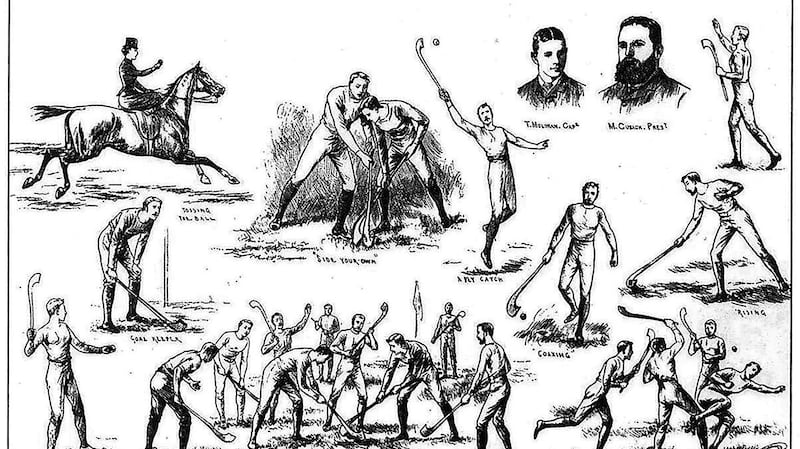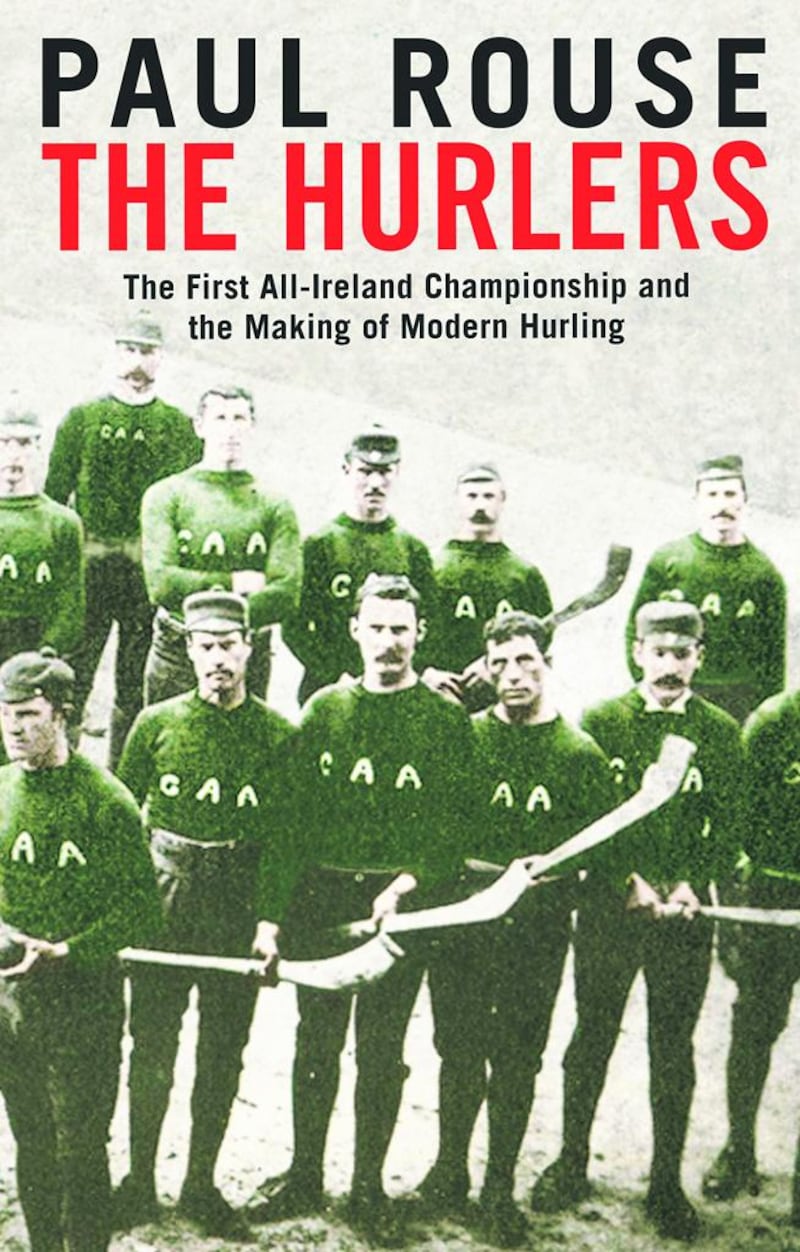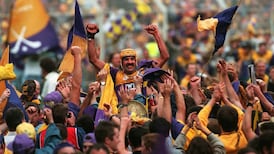As early as 1886, newspapermen began to refer to Tipperary as "the home of hurling". As much as it may have galled the rest of the country's hurlers, there was a certain justice to this. In those first years of the GAA, there were more hurling matches played in Tipperary than in any other county; and in February 1887, Michael Cusack remarked: "The championship of Tipperary is almost as good as the championship of Ireland."
The idea of their own pre-eminence was a burden carried lightly by the people of Tipperary: it was seen by them as a simple matter of fact.
Writing about North Tipperary, Cusack conjured a sort of Gaelic idyll: “The inhabitants of this romantic locality live within the mountainous barriers and strongholds which nature, itself, has reared to preserve their liberties and their national pastimes. These are barriers and strongholds, beyond which degenerating and demoralising games and customs have never penetrated, and the glorious game of hurling, so much cherished, so much loved in North Tipperary, holds deserved supremacy over all other games.”
It was here, he wrote, that his dreamed-of classless sports organisation already existed: “The doctor and officer and priest mixed promiscuously with hardy sons of toil and the blackened sons of Vulcan.” Tipperary was the benchmark by which every other county would be judged. Reporting from a match in Avondale, Co Wicklow, Cusack wrote: “I could scarcely bring myself to believe that I was not in the heart of Gallant Tipperary, so enthusiastic were the crowds, so charming were the girls, and so thoroughly Gaelic did everything look.”
Large wagers
This elevation of Tipperary was as rooted in the past as it was in the present. There was evidence of centuries of hurling in the county, including the discovery of ancient bog-preserved hurling balls made of hair. More than 300 years of poetry, legal statutes, memoirs, travel journals and newspaper articles recorded the presence of hurling in Tipperary’s fields and village greens.
In the eighteenth century the game enjoyed the patronage of the landed gentry, who kept teams that played each other for large wagers. The social and political ruptures of the nineteenth century had reshaped social life in Tipperary, but hurling had survived in places such as Clonoulty and Moycarkey up until the establishment of the GAA. Cusack was able to employ this apparently unbroken tradition of hurling towards his vision of what the GAA should be.
Despite Cusack’s vision of Tipperary as a Gaelic redoubt, it was, in reality, a strikingly diverse county. It was home to substantial landowners who developed their own sporting lifestyle that revolved around hunting, shooting, fishing and tennis parties. Many other sports of Empire also thrived. Rugby clubs were well established across the county by the 1880s and cricket was the most popular game, played by all sections of the community.
After 1884, the relationship that developed between the GAA and sports such as cricket and rugby was a complex one. The Tipperary Advocate, based in Nenagh, wrote that the GAA was, in part, designed to "banish the namby-pamby croquet, lawn tennis, etc., as effectively as St Patrick banished the more vicious serpents from our isle. We have not the slightest objection to effeminate dandies and romantic ladies to amuse themselves at the exciting games quoted, but they are far, very far, beneath the brawn and sinew of the hearty sons of Tipperary."
The problem for such rhetoricians was that the games of Empire thrived in Tipperary long after the founding of the GAA. And they thrived, on occasion, with the help of the GAA. After Clanwilliam won the Munster Senior Rugby Cup with victory over Garryowen in March 1887, among those whom the club thanked were the GAA members who had left nothing undone “to help their rugby friends make their match a complete success”.

A member of the Clanwilliam club was St George McCarthy, who had played rugby with Cusack in Dublin and had also attended the first meeting of the GAA in Thurles in 1884, though he did not subsequently involve himself with the organisation. Even the language of such sports entered the GAA, with Tipperary footballers reported in the press as shouting such encouraging words as "Bravo, Conway" and "Darling to your left foot, Carty", to each other. For their part, local landlords also supported GAA clubs. When Silvermines played Tulla from Clare in October 1886 they did so in a field provided by Lord Dunalley.
****
The people of Tipperary immediately embraced the GAA. On top of that, the games were adopted by Catholic clergymen. Some simply threw in the ball in symbolic fashion to start matches. Others had a more central role: they became club officials and placed hurling at the centre of parish life. The local curate in Dunkerrin, Fr John Maguire, was a well-known lover of hurling who celebrated a hurling match between two Tipperary teams by killing a pig and boiling six stone of bacon for the occasion. Although the clergy were involved in clubs and attended matches, it was primarily individuals such as Frank Maloney, from Nenagh, who drove the revival of hurling in Tipperary.
Like many other sports lovers in the county in the 1880s, Maloney was initially a cricketer. In fact, he was honorary secretary of the Nenagh Cricket Club in 1884 when the GAA was founded. He immediately began chairing a subcommittee of that club which was appointed for “the revival of national pastimes”. Within a month of the founding of the GAA, the Nenagh Cricket Club began planning to hold a hurling match. By March the subcommittee had evolved into the Nenagh Hurling Club and, on that Sunday in March 1885 when the first hurling matches were played under GAA rules, Nenagh played a team from nearby Silvermines, with Maloney as referee.
Throughout 1885, Frank Maloney’s efforts were crucial to the formal organisation of hurling across the northern part of Tipperary. He had begun corresponding with Cusack in late 1884, and it was to Maloney that Cusack had turned when he wanted to stage his great hurling spectacle in Dublin in early 1886 by inviting a team from North Tipperary to play one from East Galway in the Phoenix Park.
Trial matches
Maloney had arranged the trial matches for players from all the various villages and parishes around Nenagh to choose the North Tipperary team. He used the momentum generated by their victory to establish a sort of umbrella organisation for clubs in the areas – the North Tipperary Branch, GAA. In the latter part of that year and into 1887, Maloney arranged a competition between all the clubs of the area; the prize was the silver cup that had been won by the North Tipperary all-star team in Dublin in February 1886. It says much for Maloney’s ability that he was scarcely 20 years old at the time.
Cusack, always at pains to romanticise Tipperary hurling, wrote: “We have seen teams of Tipperary hurlers with their blood boiling for hours, and we have not detected the slightest symptom of the revival of faction fighting, or any fighting at all. They want hurling, not fighting.”
The reality was that there was fighting everywhere. In his column in Sport, P. P. Sutton became increasingly obsessive in his criticism of rough play during 1887. At the start of the hurling championship, Sutton had appealed to all clubs to ensure that matches would be played “in a friendly spirit, with mutual toleration, and without the introduction of rough or vicious play, which serves no purpose whatever and only brings ridicule on those who indulge in it”. He was proud that the Dublin hurling championship had passed off without violence, but he also believed that the rules of hurling were more faithfully observed in Dublin than in other counties, not least in Tipperary.
He was exasperated by the “rough, vicious and semi-barbaric play” of various rural teams: “Butting with the head, kneeing in the stomach, giving the elbow in the ribs under the cover of hipping, tripping, and a few other minor forms of what we must call ‘deceitful play’.”
And that was not even to mention the crimes committed with the hurley. Local observers in Tipperary lent credibility to Sutton's claims. Canon Philip Fogarty noted that matches involving teams from the county had occasionally been abandoned "lest humanity too far forget itself". When Hollyford met Cappamore, "play had scarcely commenced when a camán was smashed in smithereens. This was an accurate prognostic of what was to come."
On New Year's Day 1887, the Tipperary Advocate listed serious incidents in a match on Christmas Day at Rossaguile, and in matches in Nenagh and Tyrone on St Stephen's Day. According to the paper, all the incidents were the product of rough play and would have been avoided if "the shoulder jostling was left out of the fair hurling of the ball". Elsewhere in the county, there were reports of "disgraceful scenes" in Clonmel when a team from Carrick travelled over for a match which devolved into a fracas, then into a brawl and, finally, into a bout of stone-throwing.
The police were called, arrests were made and several players received fines. It seems to have provoked no small amount of bitterness among the Carrick men that not one Clonmel man was arrested or fined. Responsibility for keeping violence at bay fell to the referee. It was no easy task. The rules of hurling were still being refined and were, in many instances, no more than vague guidelines.
More than that, the whole concept of refereeing was a new phenomenon in hurling. Even as the first championship was getting under way, a system was still being worked out. A referee was to be assisted in his duties by two field umpires, one of whom was appointed by each team. In seeking a decision, the captain of a team was supposed to appeal to the umpire from his club, who would then appeal to the referee, who would convey his decision to the players.
This system of decision-making by committee led to matches frequently being stopped as participants gathered around the referee awaiting his decision. Inevitably, umpires sought to use their position “to try and gain, fairly or foully, all the advantages they possibly can for their side”. Players were given to disregarding the referee’s authority or using “classical language” to abuse him. Teams who felt particularly aggrieved were known to leave the field in protest.
Badgered
The situation was not helped by the confusion caused by crowds spilling on to the pitch. A supporter of the Mooncoin hurlers in Kilkenny was reported for flourishing an umbrella while he badgered a referee. Supporters of the Templemore club pulled up the goalposts when a match was headed in a direction of which they did not approve. The stewards supposedly responsible for keeping order could also become caught up in events. At the Wicklow championships in Parnell’s lands at Avondale there were “stewards and spectators freely using ash saplings on one another’s heads in a manner worthy of the halcyon days of faction fighting”.
Amid the general mayhem, the referee was expected to rule the game by shouting instructions. This was obviously open to malice and mischief. Members of the crowd and other players were known to shout: “Take up the ball”, or “Time is up”, as the game was in full flow. Only in 1888 was it recommended that referees be provided with a whistle. But a more fundamental problem was getting suitable men to referee matches.
Sutton regularly railed against those who were chosen, believing many to be lacking in authority and impartiality: “In appointing referees their fitness for the position is very often totally disregarded and we have seen men acting as such who knew as much about the duties of a referee, or of the rules of football or hurling, as the man in the moon.” The result was still more violence. As T. F. O’Sullivan, the first historian of the GAA, recalled: “The referee enjoyed no particular immunity from rough handling. His person was by no means sacrosanct.” In Dublin, despite Sutton’s pleas, a referee was “severely beaten” by a player at a match in Clonskeagh.
Referees were verbally abused before and after games on a routine basis. One referee recalled being “subjected to the most vile abuse from the very moment the match commenced”. Threats to referees were not without reward. A report on a match in the first Louth football championship records the crowd being “convulsed with amazement” at the decision of the referee to award victory to Point Road, Dundalk, over a team from Monasterboice. All present were clear that Monasterboice were comfortable winners, but the referee confided that “if he hadn’t made the Dundalk men victorious, there would be no use in him going home”.
In Tipperary, at least one referee was determined not to be intimidated: John Cullinane – an IRB man and land agitator – carried a blackthorn stick whenever he officiated. With the Tipperary championship about to begin, the fear was that even a blackthorn stick would be of scant use: Sutton had noted that "teams will be more anxious for victory in the championship ties than in ordinary matches, and this anxiety might operate injuriously against good fellowship". For all the pious words, the reality was that it was precisely the prospect of bad fellowship which was central to the appeal of hurling in Tipperary.
The Hurlers, The First All-Ireland Championship and the Making of Modern Hurling by Paul Rouse is published by Penguin Ireland at €25.00













